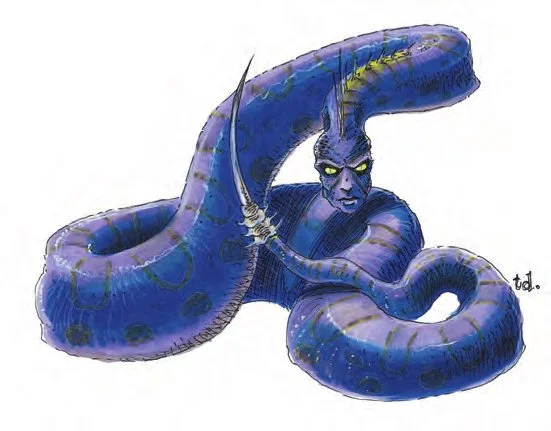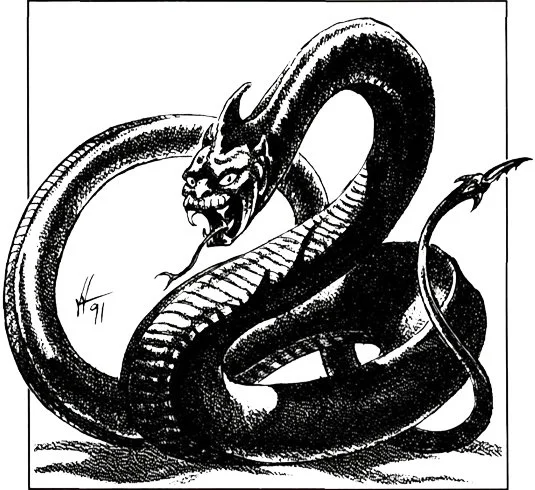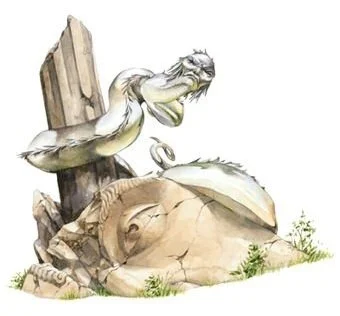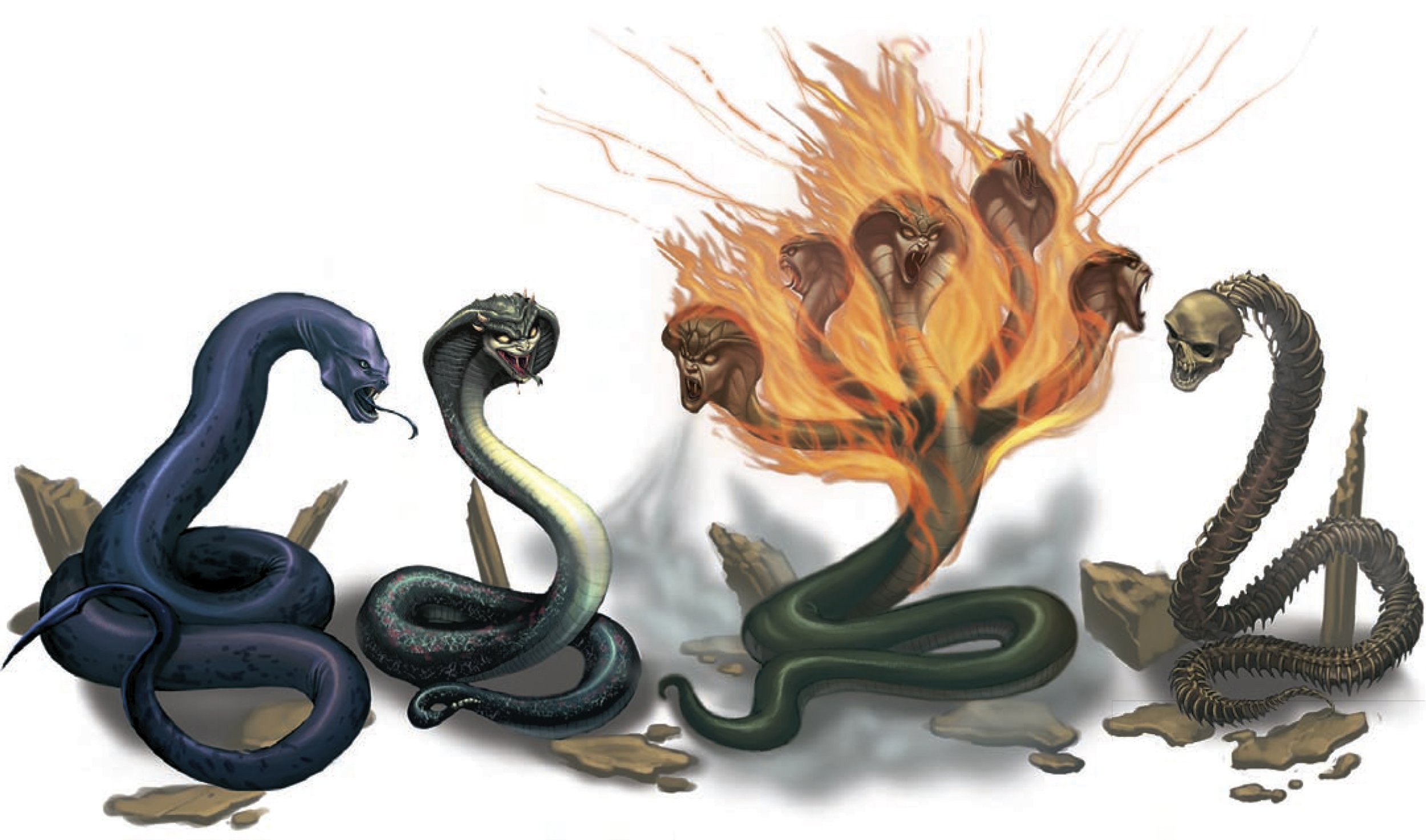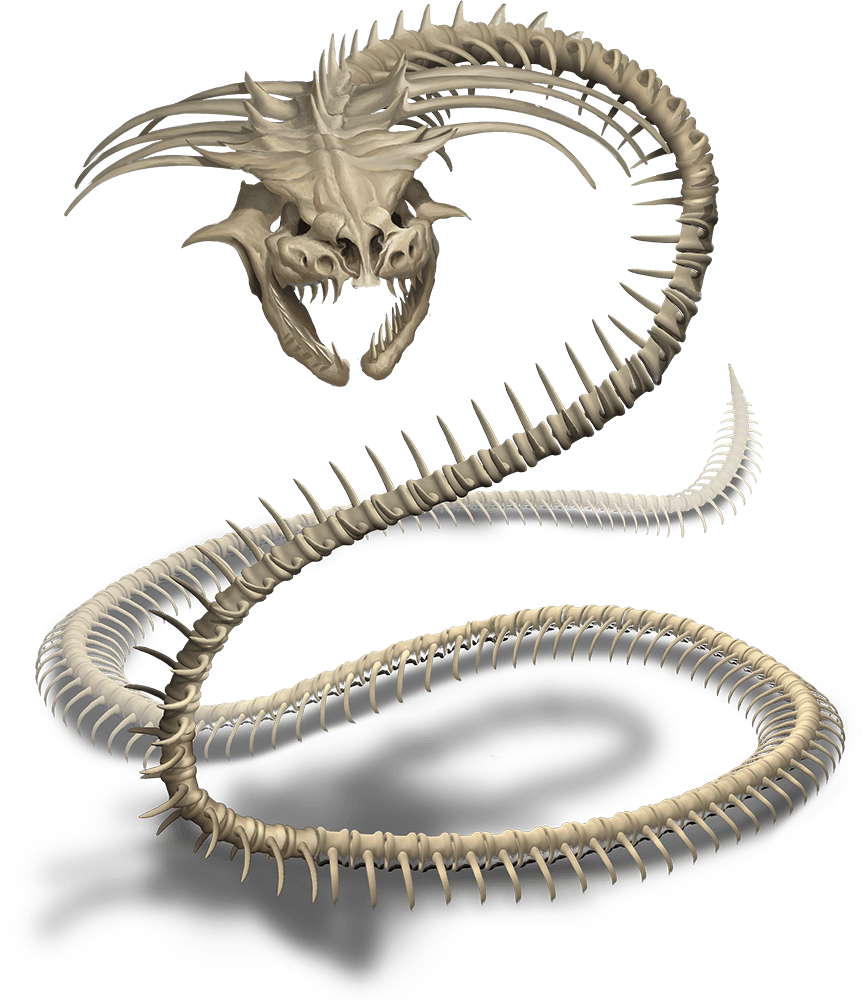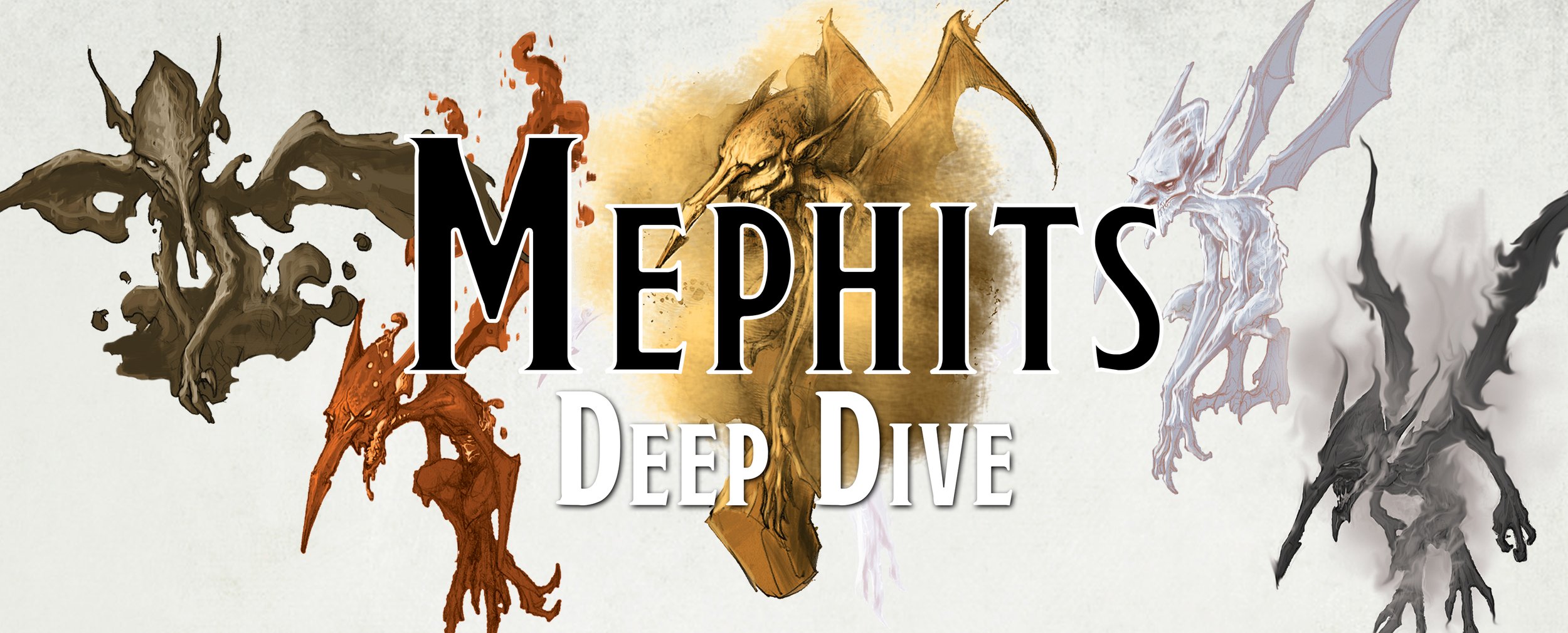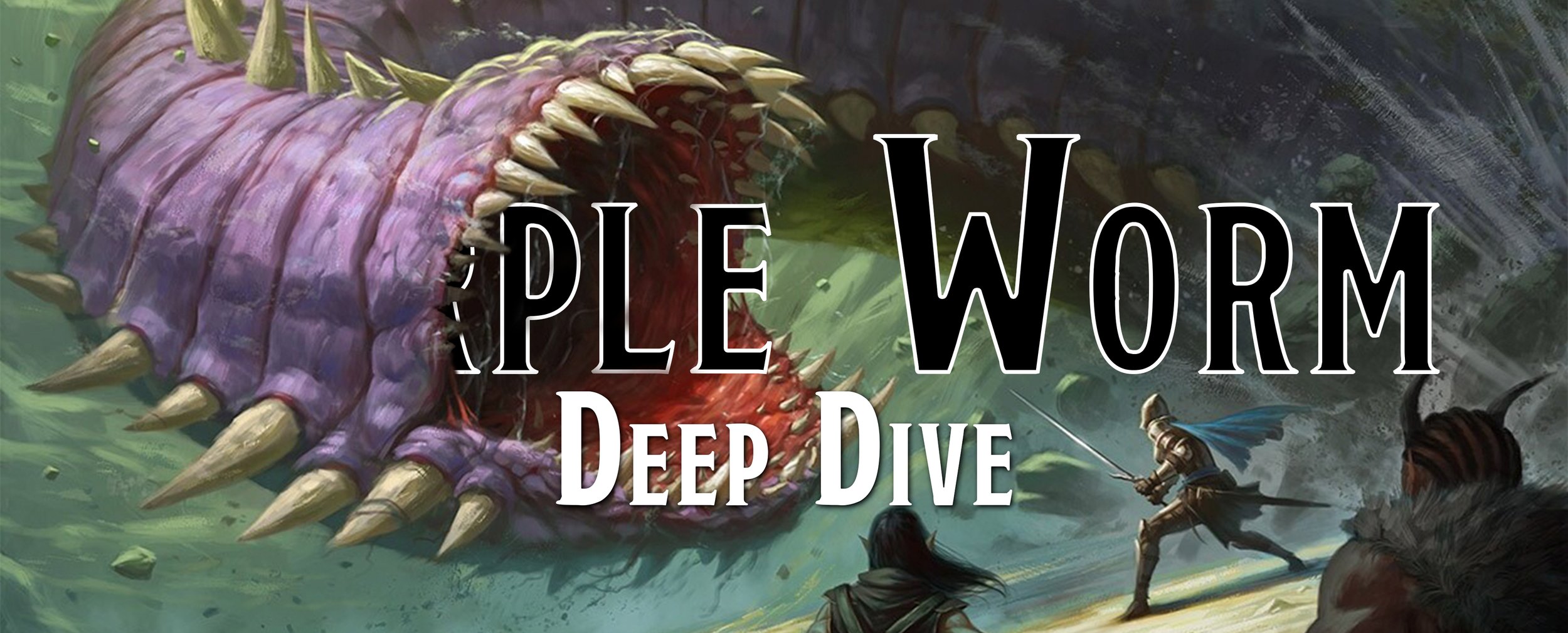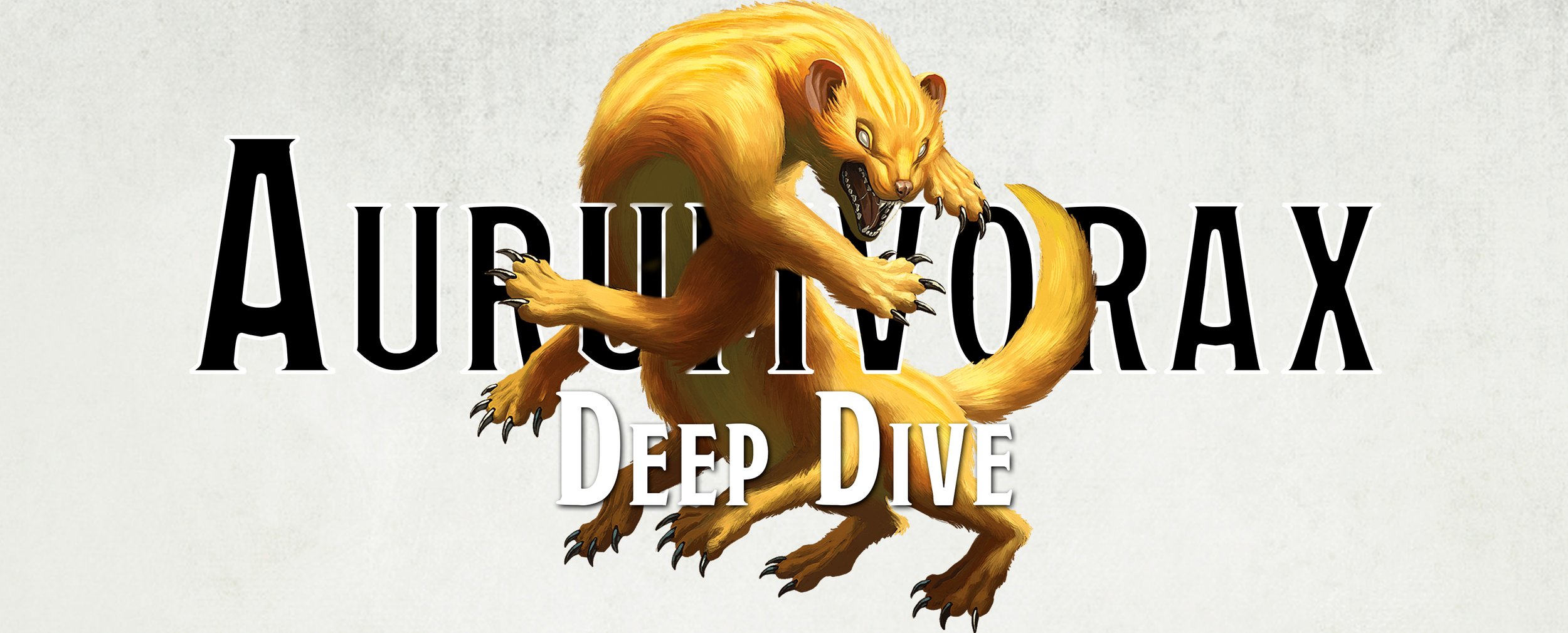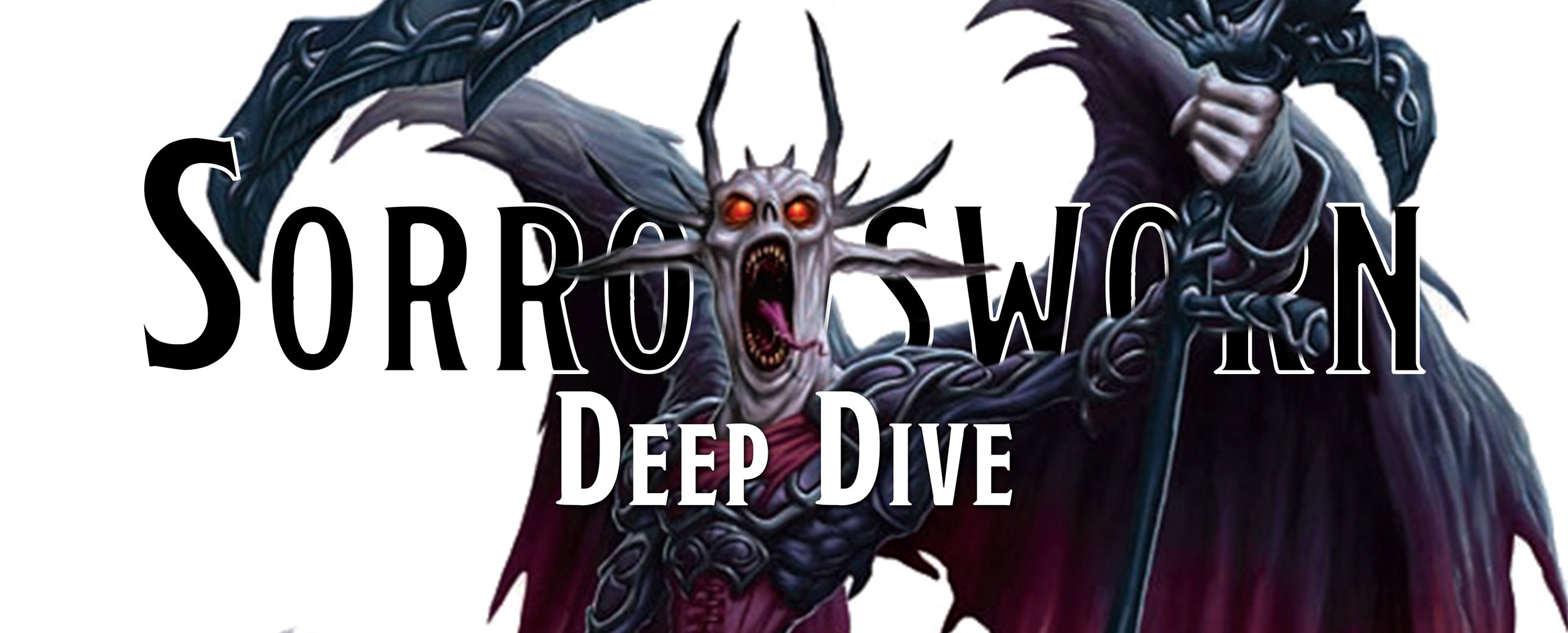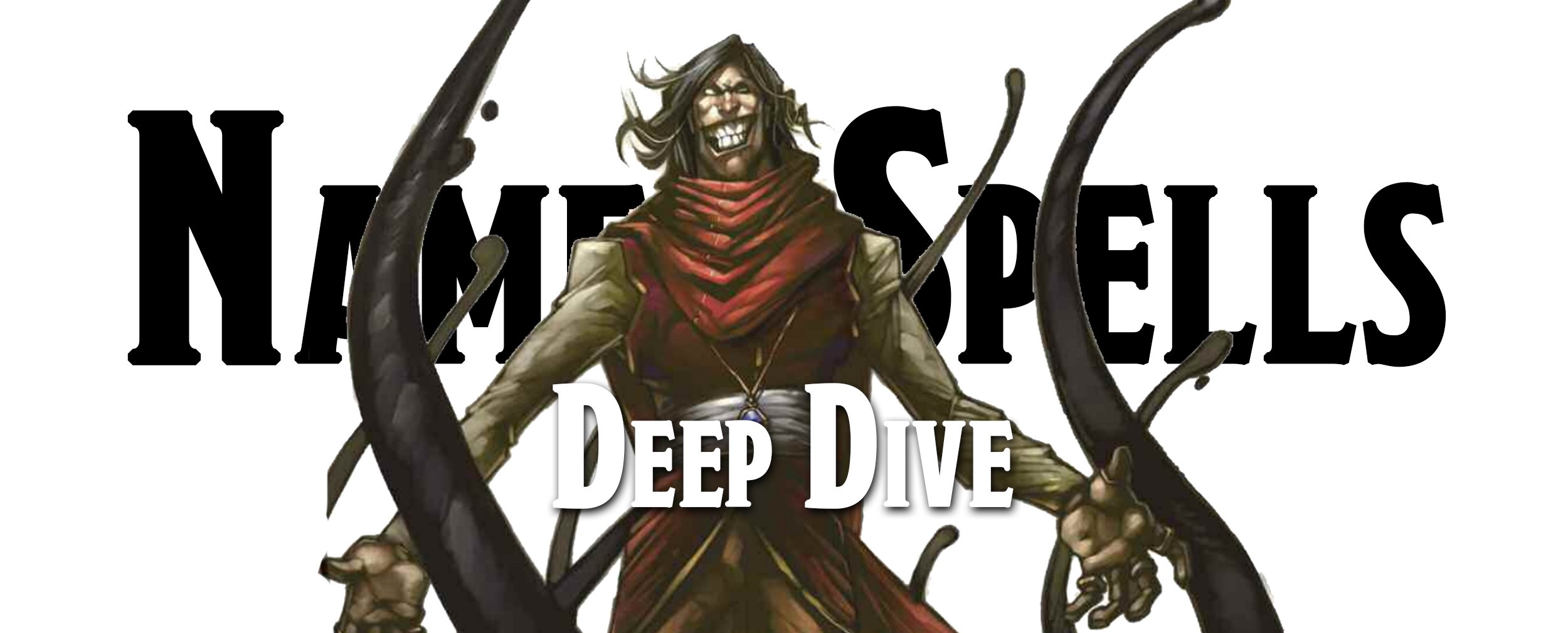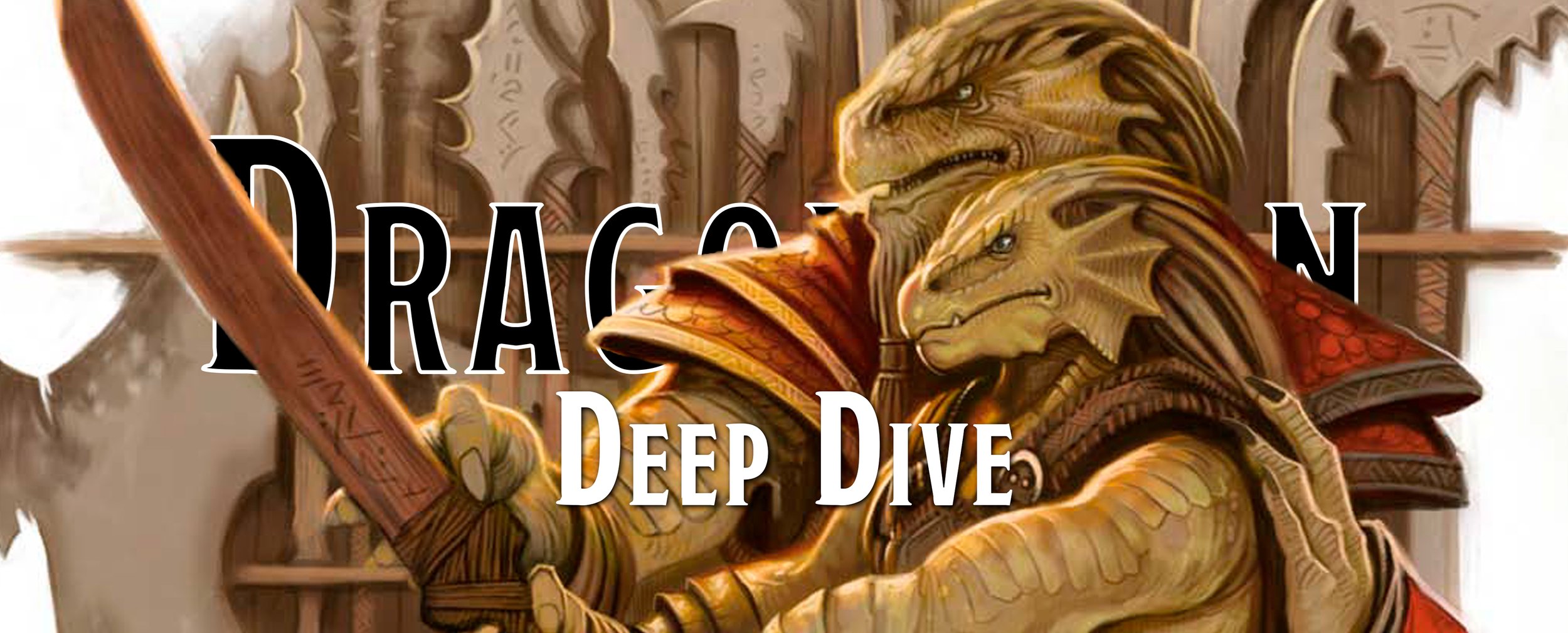Deep Dive - The Naga
There is nothing like a giant snake with a human-looking face to spice up your adventure. The Naga is that creature, and the spice is the poison it delivers through a bite or the tip of its barbed tail. They aren’t all evil, as a couple of good aligned serpents exist, and even one that embraces neutrality. The rest are pretty evil, like torture you with acidic poison evil.
OD&D - Naga
No. Appearing: 1+
Armor Class: 5
Move: 15”
Hit Dice: 7-12
% in Lair: 60%
No. of Attacks: 1 bite
Damage/Attack:
Guardian: bite 1-3* / spit 3”* / constriction 2-8;
Water: bite 1-4
Spirit: 1-3 / +special
Treasure: Type H
*must also make saving throw vs. poison
The Naga first slinks forward in the Strategic Review Vol.1 No. 3 (Autumn, 1975) in the Creature Feature with three different versions of them. They are described as snake-like in form, you don’t want to get bit, and they can cast spells; that’s about all that they share in common. The three types are Guardian, who are found in sacred places or guarding important treasures of lawful creatures; Water, who are the most numerous and are found in only fresh water; and Spirit, who are vile Naga that are totally evil.
The Guardian Naga is about 15 to 20-feet in length and has the most options when it comes to attacking, from biting, to spitting, and even to constricting you like a snake. If it bites you or spits on you, you have to roll a saving throw against poison or you die. While that might seem harsh, well, it is, and you should’ve made the save if you wanted your character to live. If you do succeed against being poisoned, watch out as it will try to wrap its snake body around you and start squeezing you, or maybe it’ll decide to cast some cleric spells. Luckily, it can only cast up to 4th-level spells, which means you only have to avoid it turning sticks into snakes or creating water.
Water Naga are the most numerous of all Naga, though you are only going to find them in sources of fresh water, and probably only deep fresh water at that. They reside in palaces deep beneath the surface of ponds and lakes, probably coming up with a form of government involving the distribution of swords from women. They also utilize their bite to deliver an insta-death poison, and cast spells, but they aren’t a cleric. Instead, they can cast spells like a magic-user up to 3rd-level spells like fly or haste. Luckily for you, they can’t cast any fire or lightning spells because they live underwater and we guess those spells don’t work down there.
The last type of Naga are the dread Spirit Nage who are basically just evil. These Naga alone have a horrific visage, that of a human head atop their snake bodies. Not only will their bite instantly kill you, but merely looking at their eyes is enough to permanently charm you unless you can save against paralysis. They are able to cast cleric and magic-user spells up to 4th-level with no restrictions, which means fireball is back on the menu, but also wall of fire and dimension door.
AD&D - Naga (Guardian)
Frequency: Very Rare
No. Appearing: 1-2
Armor Class: 3
Move: 15”
Hit Dice: 11-12
% in Lair: 75%
Treasure Type: H
No. of Attacks: 2
Damage/Attack: 1-6/2-8
Special Attacks: See below
Special Defenses: Nil
Magic Resistance: Standard
Intelligence: Exceptional
Alignment: Lawful good
Size: L (20’ long)
Psionic Ability: Nil
Spirit Naga - Monster Manual, 1977 TSR Inc.
We are introduced to the Naga in the Monster Manual (1977) and this trifecta of snake-creatures covers the spectrum of alignments with lawful good, neutral, and chaotic evil. There are still just the three of them, though we can’t imagine that they ever cross paths. Like before, don’t get bit by them unless you just like getting bit by massive snakes. We won’t judge. Unlike before, their bite isn’t going to immediately kill you instead, you get to save or take half damage from their bite’s poison.
The first Naga to look at is the Guardian Naga, a wise creature that guard, as their name hints, sacred sites, treasure accumulated by good aligned minions, or spend their time watching over evil. They are beautiful creatures, with gold eyes and green-gold scales with silvery triangles that run down their backs. Of course, if they happen to be guarding something you want, be ready cause they can bring the pain, and by the pain, we mean a poison spittle that immediately kills you if you fail the single saving throw against it. If that isn’t enough, they still have their cleric magic they can cast upon you.
The polar opposite is the Spirit Naga, even their alignment is the exact opposite with them being chaotic evil. Their snake-body features black scales with crimson bands, and they have the awful human-like face on their bulbous heads with even hair on top. These Nagas are evil to the core, and like most creatures of the same ilk, they live in the dark, creepy places adventurers roam looking for glory and treasure. The Spirit Naga have similar but slightly different abilities and attacks. Their bite is also poisonous, and they also have spells. They also have cleric spells and they can cast magic-user spells, though they aren’t quite as adept as the others at their respective magical traditions. We strongly advise not meeting their gaze if you fight them, though that will make fighting them difficult. If you do look, and remember we said not to, you'll be permanently charmed if you fail your saving throw. We guess it's better than instant death, but do you really want to spend the remainder of your life as a Naga's lackey?
The final Naga is the Water Nage and is the balance between the others as they are Neutral. They spend their time lounging in freshwater ponds and lakes, though there is no mention if they still have a palace as it is just called a lair. They may be hard to spot whle in the water as they are emerald green to turquoise in an interlaced pattern with chocolate brown and pale jade green or dark gray and olive scales. They are curious by nature, but that curiosity doesn't extend to testing your fighting abilities. Water Nagas won't attack unless you tick them off or decide to attack them. They don't have anything that will ruin your day with a single saving throw being the deciding factor, though that doesn’t make them meek. They have a deadly poisonous bite and spellcasting abilities, capable of casting up to 3rd-level magic-user spells, so like lightning bolt. Yup, that’s right, they can now cast electrical spells, but fire is still kept from them.
2e - Naga (Spirit)
Climate/Terrain: Subterranean
Frequency: Rare
Organization: Solitary
Activity Cycle: Night
Diet: Carnivore
Intelligence: Highly (13)
Treasure: X (B,T)
Alignment: Chaotic evil
No. Appearing: 1-3
Armor Class: 4
Movement: 12
Hit Dice: 9-10
THAC0: 11
No. of Attacks: 1
Damage/Attack: 1-3
Special Attacks: See below
Special Defenses: Nil
Magic Resistance: Nil
Size: H (15’ long)
Morale: Elite (14)
XP Value: 5,000
Dark Naga - Monstrous Manual, 1993 TSR Inc.
Appearing in the Monstrous Compendium Vol. 2 (1989) and Monstrous Manual (1993) we are given quite a bit more information about the Naga species as a whole. As previously discussed, Nagas are incredibly intelligent and live exceptionally long lives. Your grandkids could quite possibly encounter the same Naga that ate you, but that is, of course, if they want to be found. They now all get the creepy human-looking heads, which can be quite disturbing as it's attached to a 20-foot long snake body. They are covered in shiny scales, and you can tell if you're in trouble by their color. Their skin can be harvested and fashioned into magical scale mail, and their eyes are used as materials for higher-level spells. If all of this terrifies you, we have something to put you at ease. Sometimes, Naga carry little fanny packs around their necks to help them carry things. There, do you feel better now?
Nagas have a small territory they call their own, and it is theirs alone, for they are solitary creatures. This doesn't mean they won't find a partner, but that relationship doesn't last long. Once the female is pregnant, she will depart and find a safe place to lay and abandon her eggs, letting the snakelets survive on their own. They live in the dark, either in a deep hole or the ruins of a building. If you stumble through their lands, you may not see them, for they can lie perfectly still for hours, watching and waiting for you to pass on by. They don't like intruders and will use traps to pin down potential trespassers.
Spells are the most formidable weapon in any Naga's arsenal, and they will cast them first in combat. All three Nagas have the same spellcasting as before, and they still have their special abilities with a few modifications. The Guardian Naga’s poison can be spat up to 30-feet away, which is the same as before, unless you took the 3” range literally. The Spirit Naga has eyes that mystify, causing you to be charmed, though luckily it is based on the charm person spell which has different durations depending on how smart you are. If you have an Intelligence score of 3 or less, you get to repeat the saving throw every 3 months. If you have a big brain like us… well, maybe not like us… you get to make the save every day if it is 19 or higher. For most people, you are looking at weeks in between each check, which is far better than just a permanent charm effect on you and you get to roll up a new character.
Dark Naga - Monstrous Compendium Forgotten Realms Appendix II, 1991 TSR Inc.
This edition also brings with it new Nagas to devour your players and their characters. First shown off in the Monstrous Compendium Forgotten Realms Appendix II (1991) and then reprinted in Monstrous Manual, the Dark Naga is an evil and foul Naga, just in case the name wasn’t enough of a giveaway. They are specifically called fey creatures and are lawful evil, meaning they’ll still eat you, but they’ll obey orders from stronger creatures that employ their services - which could include to not eat you.
While they are typically found alone, like most Naga, they do sometimes form family units of up to three. They love making their lairs in rocky places, like caverns or ruins, and hide their treasure there, like magic items, spellbooks, and gold. Though, that is if they have any gold. You see, Naga’s lack hands due to having snake bodies and so can only cast spells that are verbal only. To get around this major restriction, they spend vast amounts of treasure to pay teachers, like dragons and other spellcasting creatures, to help them learn how to turn spells, like fireball that requires bat guano, into spells that don’t require anything but speaking some funny words. This is an expensive process that requires lots of testing, and so they are always looking for more treasure to offer up so that they can start trying out new spells to cast as verbal only.
But you might be wondering how they accumulate this hoard; its not like they have hands to carry their treasures home with them. If they do come across such items, maybe from your still warm corpse, they will gobble them up, storing them not in their acid-filled stomach but in a unique internal organ for that sole purpose, thus ending the practice of fanny packs as apparently all Nagas have this internal organ. Once safe and sound at home in their cave or ruins, they spit out any objects gathered in there and begin the work of learning the object's magical secrets. There is no provided limit on what they can carry about in their gullet, but we can imagine that they probably can’t fit more than a backpack worth of goods in there, or else they start looking really silly with the impressions of books, quills, wands, and more poking beneath their scales.
If you do happen to fight these creatures, probably because you have a pulse, you have a few things to worry about. While they do bite like their cousins, it isn’t poisonous by default. We say default because they can ingest poison, acid, or venom and store it in their body for another day. They can bite you and then inject this poison into the bite or simply spit it into your face up to 10 feet away. If a bite with no poison sounds like a cakewalk to you, we should also point out they have a tail that ends in a poison sting, so it’s not like they aren’t defenseless. If they hit you with this tail, get ready for a power-nap if you fail the save as you have 1 round before you are knocked unconscious for up to 8 rounds while the rest of your party screams for you to wake up to no effect. All this and they still have up to 3rd-level wizard spells to cast on you.
Bone Naga - Monstrous Compendium Annual Volume 1, 1994 TSR Inc.
Our final Naga in this edition is the Bone Naga found in the Monstrous Compendium Annual Volume 1 (1994). You’d be forgiven if you confused this creature with a necrophidius, but sadly it would be the last mistake you ever made. Bone Nagas are undead, created by Dark Naga and evil mages who wish to use them to serve as guardians, though there is no clarification about how they are created. It could be from the dead body of a Naga who is no longer using their skeleton, or perhaps they get into crafts and combine a snake body with a human skull they find lying around not being used. Regardless, they have their own sentience and personality, using telepathy to talk to others, probably letting them know they can’t wait to have a few new undead friends.
When Bone Nagas bite, they also force their victim to save against spells, and on a failure you begin to feel weaker. You lose a point of Strength every time you fail against their horrible bites, regaining 1 lost point every hour that you are still alive. They can also sting you with their barbed tails that inflict physical damage plus what they call chilling damage that comes with no saves. If being bit and stung isn’t enough, they can also cast up to 3rd-level wizard spells and are not restricted by somatic, material, or verbal components as they use their silent force of will to do so. Unfortunately, they lack versatility and their spells are locked in once they are created, never being able to change them at a later date.
These Naga are found in the employ of evil creatures looking to commit dark acts, like a Dark Naga, evil mages, foul-natured dragons, or even on their own if their master happens to die. They can even be given their freedom if their master abandons them, the same way you abandoned your tamagotchi pet all these years… except that pet probably doesn’t go around murdering people for fun. If you do happen to find a wandering Bone Naga, get ready as they like to accumulate lesser undead around them as they probably get quite lonely in their undead life.
Dragon #261, July, 1999 TSR Inc.
This isn’t the all for this edition as the Dark Naga get a bit more lore written about them just before the end of this edition in Dragon #261 (July, 1999) in The Ecology of the Dark Naga article written by Johnathan M. Richards. This story revolves around a group of wizards who have tracked down a Dark Naga to its cavernous hole and are trying different methods of killing the creature without getting themselves killed in the process. They try using cloudkill, but Dark Naga are immune to all magical and non-magical poisons, venoms, and acids; and even use a chicken on a hook to trick the Naga into biting onto it like a fish, unfortunately for them the Dark Naga uses a Bone Naga to bite onto it, tricking the party of wizards.
We do finally learn how they make Bone Nagas and it is a painful ritual for everyone involed, requiring a Dark Naga to die. Their corpse is then placed in a circle so it’s tail spike is in its mouth and then other Dark Naga, and evil mages, circle around and begin performing a ritual for many weeks as the body naturally decays. This long and tedious process also causes plenty of pain to the Dark Naga performing the ritual as they must sacrifice their own hit points, that slowly recover over the next few weeks, to fuel the undead corpse of the Bone Naga.
After the wizards deal with the Bone Naga, they realize that the Dark Naga has ESP, allowing it to read their thoughts and plans, and countering it. They retreat a safe distance of 100 feet back and decide that one of them will teleport into the Dark Naga’s nest and try to cast charm monster on it. Unfortunately for them, they didn’t realize that Dark Nagas are quite resilient against mind-controlling spells and the Naga tricks the wizard into thinking that the spell worked before it lashes out with its venomous tail, causing the wizard to fall asleep. While the wizard is asleep, it tries to eat him, but is quickly attacked by the wizard’s familiar, a curious six-legged rat called an osquip, that kills the Naga while it is trying to swallow the wizard like a snake swallows a rat.
The morale of this story, from our point of view at least, is that Nagas are sarcastic, deceitful, and straight-up tricky. Oh, and make sure you have a familiar willing to risk its life to save your dumbass when you come up with a plan that will backfire immediately.
3e/3.5e - Naga (Guardian)
Large Aberration
Hit Dice: 11d8+44 (93 hp)
Initiative: +2
Speed: 40 ft. (8 squares)
Armor Class: 18 (–1 size, +2 Dex, +7 natural), touch 11, flat-footed 16
Base Attack/Grapple: +8/+17
Attack: Bite +12 melee (2d6+7 plus poison) or spit +9 ranged touch (poison)
Full Attack: Bite +12 melee (2d6+7 plus poison) or spit +9 ranged touch (poison)
Space/Reach: 10 ft./5 ft.
Special Attacks: Poison, spit, spells
Special Qualities: Darkvision 60 ft.
Saves: Fort +7, Ref +7, Will +11
Abilities: Str 21, Dex 14, Con 19, Int 16, Wis 19, Cha 18
Skills: Bluff +18, Concentration +19, Listen +13, Diplomacy +8, Disguise +4 (+6 acting), Intimidate +6, Sense Motive +18, Spellcraft +17, Spot +13
Feats: Alertness, Combat Casting, Dodge, Eschew Materials, Lightning Reflexes
Environment: Temperate plains
Organization: Solitary or nest (2-4)
Challenge Rating: 10
Treasure: Standard
Alignment: Usually lawful good
Advancement: 12–16 HD (Large); 17–33 HD (Huge)
Level Adjustment: -1
Spirit Naga - Monster Manual, 2003 WotC
We get the Naga in the first Monster Manual (2000/2003) along with a very brief general description for these aberrant snake-spellcasters. In addition, the Dark Naga joins the big leagues and is now grouped with the Guardian, Spirit, and Water Nagas, no longer unique because it gets its own page. We'd like to consider that an upgrade, but we're willing to bet the Dark Naga doesn't see it the same way. Just like before, they are snake-like creatures with somewhat human-like faces. They range in size from 10- to 20-feet long and weigh from 200 to 500 pounds. After that, we start getting specific information about each one of them.
Much of the information holds true from before, with the biggest changes involving their poison. They can all deliver poison, though the Dark Naga uses its tail barb instead of its teeth. The Dark Naga is unique in that it’s poison causes you to fall into a nightmare-filled sleep for up to 8 minutes, while the others all use their teeth to inject a poison that deals direct damage to your Constitution score, potentially killing you if it reduces your Constitution to 0… which isn’t too hard to do when you are rolling d8s and d10s to determine how much damage you take.
Bone Naga - Monster Manual 2, 2002 WotC
All of the Naga are capable of casting spells, all casting them as if they were 7th level sorcerers which simply determines what spell list they have to learn spells from and that they are going to have a slower spell progression than if they hit the books and were wizards. At 7th level, wizards are slinging 4th-level spells, but sorcerers still only have their 3rd-level spells; they just get up to six of each spell level while wizards are stuck at only getting four of each level. Guardian Nagas are unique in that they are treated as 9th level sorcerers, meaning they get 4th-level spells, which just goes to show that being evil and cruel and committing crimes doesn’t pay. Most of their spells are all going to be focused on buffing spells like invisibility, but also with a good mix of damaging spells like fireball except for the Water Naga as they are still scared of fire. In addition, Guardian and Spirit Nagas get access to the cleric spell list and also the Chaos, Evil, Good, and Lawful domain spells, though we’ll let you figure out which Naga gets which two domains.
It is at this point where the Naga floodgates are unleashed with Monster Manual II (2002) and Serpent Kingdoms (2004) where we can find not just the Bone Naga, but also new ones with the Banelar Naga, Faerunian Ha-Naga, Iridescent Naga, and the Nagahydra. You shouldn’t be surprised when we tell you that all save the Iridescent are evil or neutral, and only the Nagahydra is considered neutral and they hunt and kill any creature they deem to be a lesser being, which is probably everyone.
Serpent Kingdoms also provides a bit of history on the Naga, as they were created to be the servants of the Sarrukh and are the end result of magical interbreeding of humans and serpents. You might wonder why someone would like a danger noodle to have the intelligence of a human, but look no further than what Nagas do today to see the purpose for creating them. They guard treasure, they explore, and conduct magical experimentation, all for the benefit of their masters until the Sarrukh eventually fell, and the Naga split into the various incarnations we have today.
Banelar Naga - Serpent Kingdoms, 2004 WotC
The Banelar is purple with green eyes, a stinger-tipped tail, and long chin hair tentacles. They adorn their chin-tentacles with rings, and they can be used to hold wands or food, most likely a chunk of your dead body. The Banelar have the best of both worlds when traveling as they can walk and swim. Both the bite and tail sting are poisonous, turning you blue as you fall unconscious for a few hours. The Bone Naga are the same as before as they are a once-living Naga, turned dead, and then turned undead. They can bite, sting, poison, and cast spells, and work tirelessly under the service of its creator until its creator dies, at which point the Bone Naga gets to travel the vast world and decide for itself who it gets to kill… which is probably everything it can sink its teeth into.
Faerunian Ha-Naga - Serpent Kingdoms, 2004 WotC
The Faerunian Ha-Naga is a colossal Naga and is worshiped by Spirit Nagas as their god, which makes it obviously evil. Their faces are more human in appearance than other Nagas and are over 100 feet in length. This is probably why they reside in the ruins of old castles and temples, so they have plenty of room to stretch out and curl up around their stolen and found treasure. The Ha-Naga is the only Naga with the natural ability to fly, even though they lack any wings, and has a combination of all other Naga powers; charming gaze, grabbing, constricting when grabbed, poison sting, and spell casting. Also, these aren’t unique creatures, which means there are more than a few out there, just waiting to gobble up some lost adventurers.
Iridescent Naga - Serpent Kingdoms, 2004 WotC
The Iridescent Naga is the goodie-no-shoes of the Naga. You’ll know them immediately by sight as their scales are reflective, giving them a shiny, multicolored look. The Iridescent Naga faces aren't as human-looking as others, which may have something to do with the feathers they have instead of hair. The feathers run all the back down their back, creating the longest mullet the world has ever seen. They are curious creatures, spending their lives wandering the lands searching for beautiful and strange places to explore. The Iridescent Naga isn't much of a fighter, but it will defend itself when backed into a corner. They have the usual poison and spellcasting ability, but also a unique ability. Their unique ability is being able to Hypnotize their foes, which the Naga will always attempt first to avoid bloodshed.
Our final Naga is the Nagahydra who is most often found either in ancient ruins or wandering through the jungles, biting and eating anyone that gets within 10 feet of its five heads. They have single color for their scales, but can range in color from black to crimson, to purple, green, red, orange, or anything else. Even their heads can be different colors from each other and their main body, making many believe that a swarm of Naga are descending upon them instead of just one, massive Naga. They can cast spells just like a regular Naga, except up to 8th-level, and their heads regrow just like a normal hydra. Apart from the god of Naga that is the Ha-Naga, the Nagahydra is the most powerful of all Naga coming in at a challenge rating of 18. They are no joke and will have no problem gobbling you up.
Nagahydra - Serpent Kingdoms, 2004 WotC
Shinomen Naga - Oriental Adventures, 2001 WotC
We’d be remiss if we didn’t talk about Oriental Adventures (2001) and the Naga found within them. We’ll briefly just say that these are more yuan-ti than Naga as they have serpent tails with a human torso. Their monster type is even reptilian humanoids instead of aberrations like all other Naga in this edition. While we can’t really count them as Naga, we can understand why they’d like to be called Naga, Naga are super cool and they are just weird serpentfolk.
4e - Dark Naga
Level 16 Elite Controller
Large immortal magical beast (undead) / XP 2,800
Initiative +11 / Senses Perception +13; darkvision
Death Rattle (Necrotic) aura 2; enemies that start their turns in the aura are dazed.
HP 328; Bloodied 164
AC 32; Fortitude 32, Reflex 28, Will 29
Immune disease, poison; Resist 20 necrotic; Vulnerable 10 radiant
Saving Throws +2
Speed 7
Action Points 1
Bite (standard; at-will) ✦ Necrotic Reach 2; +20 vs. AC; 2d4 + 6 damage, and ongoing 5 necrotic damage (save ends). Aftereffect: The target is weakened (save ends).
Death Sway (standard; at-will) ✦ Necrotic Close burst 3; blind creatures are immune; +21 vs. Will; the target is dazed (save ends). If the target is already dazed, it takes 2d6 + 6 necrotic damage instead
Alignment Unaligned Languages Common, Draconic
Skills Arcana +18, History +18, Insight +18, Religion +18
Str 22 (+14) Dex 16 (+11) Wis 20 (+13) Con 28 (+17) Int 20 (+13) Cha 22 (+14)
The Monster Manual (2008) brings in some of the well-known Nagas, but also leaves a few key ones that have been with us for every edition so far. The Spirit and Water Naga are nowhere to be seen, but we do have the Bone Naga, Dark Naga, and Guardian Naga as well as a newcomer the Primordial Naga. This edition bring some changes for their description, though they can still be found guarding treasure and magic. Some have even risen in the ranks, forcing lesser creatures, like kobolds or lizardfolk, to work for them and forcing them to worship the Naga as their god. Luckily for all adventurers out there, Naga no longer need food or water to survive, of course, that doesn’t mean that they don’t enjoy a tasty humanoid snack every now and then. We eat when we’re bored, even when we don’t need to.
Dark Naga, Guardian Naga, Primordial Naga, Bone Naga - Monster Manual, 2008 WotC
Each of the Nagas have new and old abilities. The Dark Naga is still as evil as before and gains the ability to mentally assault its enemies, leaving them with a fair amount of damage and stunned. After that, it might try to charm you and get you to move closer to it, and then lash out with its tail and fill you with a painful toxin that makes you slowed and incapable of properly fighting back. If you wonder what occupation they have now, Dark Nagas like to watch over prophecies and oracles, gathering up any items of a similar vein. They guard those magical places within the Underdark or elsewhere in the world.
The Bone Naga has the common courtesy to alert you to its presence with its death rattle, but by the time you hear the sounds, it's already too late. This rattling sound dazes you and any of your compatriots who can hear it, making it just a bit harder to focus. While you're stumbling around dazed, the Naga follows that up with their Death Sway attack, piling on the damage. If you were lucky enough not to be dazed but are hit with a Death Sway attack, you're no longer lucky, as you'll be as dazed as the rest of your friends. You’ll hear these awful Naga where secrets of necromancy exist, including the burial places of the truly evil and wicked deceased. If you want to jump through a portal to the Shadowfell, be prepared to fight a Bone Naga, as they are the gatekeepers of said portals.
The Guardian Naga can still spit poison in your face if you anger it enough. If you get too close, it will slap you about with its tail, knocking you back. The Guardian also gets a new ability to assault your brain by utilizing its Word of Pain, followed up by calling on the primal magic. It summons forth a thunderstrike, leaving you stumbling about as the Guardian decides how best to kill you. As their name might suggest, their primary purpose in the world is to guard and protect all things arcane, but also to patrol portals to the Astral plane as a side hobby.
The newest Naga is the Primordial Naga who are guardians of portals to the Elemental Choas and protectors of beings from that realm. They are a force to be reckoned with as they have many attacks and abilities you need to avoid, lest you die an agonizing death. The Primordial Naga has a Freezing Breath that can freeze your skin and give you a bit of a timeout while it kills the rest of your allies. It can then help you defrost by spitting fire at you, which is quite kind and a nice change from poison. If you are still wanting more elemental pain, they can summon the wind to smash into you or start hitting you with its flailing heads, biting you five times in quick succession, followed up with a burning sensation through your body known as acid damage.
This is the first edition to clarify that Naga are immortal, while all others have merely suggested that they could live for hundreds or possibly thousands of years. There are only a few Nagas that desert their stewardship role within in the planes, and those are the ones that will set themselves up as rules. We suppose after a few thousand years, sometimes it’d feel nice if you were the protected instead of the protector.
5e - Naga (Spirit)
Large monstrosity, chaotic evil
Armor Class 15 (natural armor)
Hit Points 75 (10d10+20)
Speed 40 ft.
STR 18 (+4) DEX 17 (+3) CON 14 (+2) INT 16 (+3) WIS 15 (+2) CHA 16 (+3)
Saving Throws Dex +6, Con +5, Wis +5, Cha +6
Damage Immunities poison
Condition Immunities charmed, poisoned
Senses darkvision 60 ft., passive Perception 13
Languages Abyssal, Common
Challenge 8 (3,900 XP)
Rejuvenation. If it dies, the Naga returns to life in 1d6 days and regains all its hit points. Only a wish spell can prevent this trait from functioning.
Spellcasting. The Naga is a 10th-level spellcaster. Its spellcasting ability is Intelligence (spell save DC 14, +6 to hit with spell attacks), and it needs only verbal components to cast its spells. It has the following wizard spells prepared:
Cantrips (at will): mage hand, minor illusion, ray of frost
1st level (4 slots): charm person, detect magic, sleep
2nd level (3 slots): detect thoughts, hold person
3rd level (3 slots): lightning bolt, water breathing
4th level (3 slots): blight, dimension door
5th level (2 slots): dominate person
Bite. Melee Weapon Attack: +7 to hit, reach 10ft., one creature. Hit: 7 (ld6 + 4) piercing damage, and the target must make a DC 13 Constitution saving throw, taking 31 (7d8) poison damage on a failed save, or half as much damage on a successful one.
Guardian Naga - Monster Manual, 2014 WotC
This edition features the Naga in the Monster Manual (2014), and while one Naga makes a valiant return, we have lost the Water Naga it seems for good. We also get the Guardian and Bone Naga, and while they are cool, we can’t help but feel a sense of yearning for a neutral-aligned serpent that has palaces beneath the waves. Strangely enough, this edition continues that the Naga are immortal, and now you can’t even kill them properly! When they die, they just come back in 1d6 days, meaning all that work you went through to put one of them down is ruined in less than a week. Though, that gives us an idea for an adventuring duo, a Spirit Naga and a rogue, cheating towns and villages out of money for the rogue to ‘defend’ the village from the dangerous Spirit Naga. Every few weeks the rogue ‘slays’ the vile Naga, and then disappears with their payment when the Naga reforms in a weekend.
If you are wondering what Naga think about the yuan-ti, since they are both serpent-like creatures, well that was very rude. They hate each other as each of them see themselves as the pinnacle of their serpent-kind and the other are just horrible mockeries of what it means to be a serpent. This doesn't mean they will never work together, but their disdain for one another rivals the Hatfields and McCoys.
Spirit Naga - Monster Manual, 2014 WotC
If you were hoping to run into a Naga, for whatever reason, you’ll most likely encounter a Naga in its lair, as they only venture out if they hear of a powerful magic item or spellbook that is of interest to them. Otherwise, they are content to live their immortal existence pouring over their books and protecting them from those that would steal them. Nothing gets in the way of pursuing arcane knowledge, for a Naga doesn't need to eat, drink, sleep, or even breathe.
If you have the misfortune of living in a Naga's territory, you'll be entirely under their rule. If you're lucky to be living where a Guardian Naga resides, they will still require you to follow their every command but rule with compassion and understanding, like a grandmother dictator. If you happen to live in the lands of a Spirit Naga, you're essentially screwed as they just love to enslave mortals, probably to help them test out their new spell they’ve been working on. The Bone Naga may have a lair or land it claims as it’s own, but they are now the creation of the yuan-ti and serve them in their endeavors. We aren’t sure if they are ever mutiny against their serpent-overlords, but we can’t imagine that they are too happy about how they were once a living, immortal Naga, now reduced to a pile of bones that can be killed and never return to life.
Bone Naga - Monster Manual, 2014 WotC
Naga are back to their own tricks, casting spells, inflicting poison damage on their bites and generally just living out their fantasies of protecting ancient secrets from greedy adventurers like you. While none of them have tails that sting you, they do all have poisonous bites and the Guardian Naga is the only one to spit awful poison at you… which doesn’t kill you immediately. Instead, all of this poison just deals some damage with a saving throw for half. We hate to say it, but we kind of miss the dangerous poisons, though, maybe just the 3e version instead of the insta-kill version from older editions.
The Naga are a strange lot and had their moment in the sun before they quickly fell away. It’s a shame as they are a very interesting monster, especially since there is such a dichotomy among their ranks. A Naga you meet might not be the worst creature in the world, and may even help you out, but watch out for those guys with the black scales, while you might think red touching black means they’ll be your friend if your name is Jack, in reality, it’s more like black touches red, you’ll be dead… like Fred.



